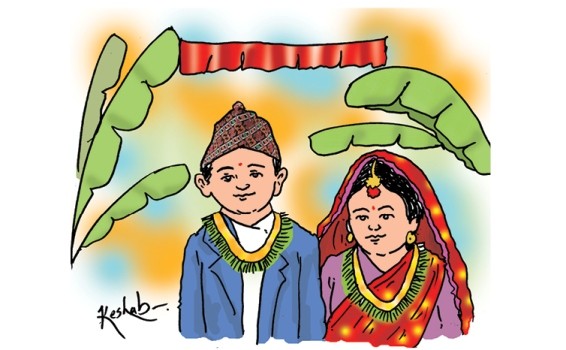Child marriage still a challenge to meet Nepal’s SDGs

By Arpana Adhikari
Kathmandu, Sept. 21: Nepal still stands second in Asia next to Bangladesh for early marriage despite incessant efforts made by the government and non-government bodies to end the child marriage practices from the country.
The lawful age to tie nuptial knot in Nepal is 20 years, which is also specified in the Country’s Civil Code, 2074. For the first time in history, the Constitution has declared child marriage as a violation of child rights and a punishable act by law.
However, child marriage continues to take place in the country for many reasons, including poverty, humanitarian context, family practices, traditional costume, peer pressure and self-initiated marriage, said Anand Tamang, Secretary of Girls Not Brides (GNB) Nepal.
According to the Nepal Health and Demographic Survey- 2016, around 40 per cent of Nepali girls get married before their 18th birthday and seven per cent before the age of 15.
While at the same time 65 per cent of women in Nepal were married as a child, a survey conducted by the GNB Nepal in 2014 revealed. The report prepared by the National Child Rights Council (NCRC) shows that as many as 196 cases of child marriage were reported in the media during the fiscal year 2018/19, in which 59 boys and 137 girls were affected.
Child marriage denies a girl not only from a single right but multiple rights during her life cycle, said Prakash Khatiwada, vice-coordinator of GNB Nepal.
“She is deprived of opportunities to quality education, meaningful participation in economic activity, heighten poverty and gender inequality,” said Khatiwada. A girl’s marriage often breaks if she is married as a child, has high risk of dying during pregnancy and child birth, including the high risk of neonatal death, said Vaijayanti Karki, National Coordinator of GNB Nepal.
On September 25, 2015, the General Assembly adopted the 2030 Agenda for Sustainable Development that included 17 Sustainable Development Goals (SDGS).
Building on the principle of ‘leaving no one behind,’ the new Agenda emphasises a holistic approach to address the global challenges we face. SDG 5.3 addresses harmful practices, such as child, early and forced marriage and female genital mutilations.
Eight out of the 17 SDG goals are directly or indirectly related to child marriage, said Tamang, adding that unless child marriage is addressed as a priority, these eight goals, Goals 1, 5, 8, 10 and 16 could not be fulfilled by 2030.
The government has committed to ending child marriage by 2030 and to accomplish this goal, the national strategy has been developed by the government in the assistance of UNICEF and GNB Nepal, added Tamang.
The Local Government Mobilisation Act 2074 has directed all rural and urban municipalities to prioritise programmes to address child marriage in their localities. Despite such progress, child marriage continues to remain a major challenge in the country, he added.
A high level government delegation is participating in the United National’s SDG Summit in New York on September 24-25 to discuss the strategies and accelerator plans to accomplish the SDG targets in the remaining 11 years.
The stakeholders have urged the government delegation to decide on the most feasible action to address child marriage and attain SDG goals.
Khatiwada said it was a high time that the government prioritised child marriage issues at the SDG Summit and made commitments to successful accomplishment of SDG goals by 2030.
Recent News

Do not make expressions casting dout on election: EC
14 Apr, 2022
CM Bhatta says may New Year 2079 BS inspire positive thinking
14 Apr, 2022
Three new cases, 44 recoveries in 24 hours
14 Apr, 2022
689 climbers of 84 teams so far acquire permits for climbing various peaks this spring season
14 Apr, 2022
How the rising cost of living crisis is impacting Nepal
14 Apr, 2022
US military confirms an interstellar meteor collided with Earth
14 Apr, 2022
Valneva Covid vaccine approved for use in UK
14 Apr, 2022
Chair Prachanda highlights need of unity among Maoist, Communist forces
14 Apr, 2022
Ranbir Kapoor and Alia Bhatt: Bollywood toasts star couple on wedding
14 Apr, 2022
President Bhandari confers decorations (Photo Feature)
14 Apr, 2022











